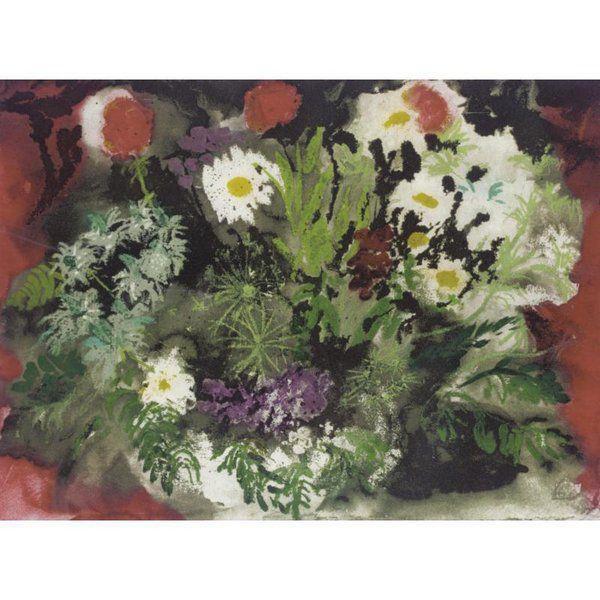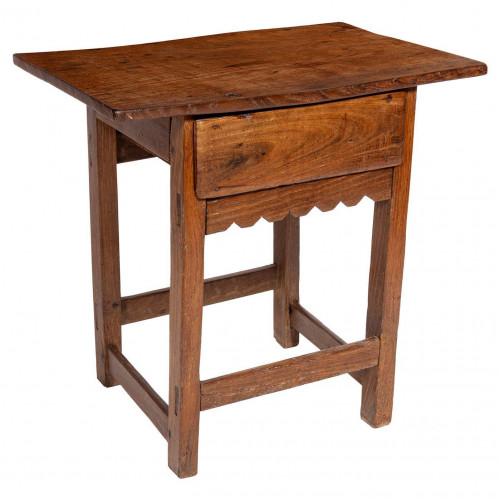Late Summer Flowers
10346
JOHN PIPER
British, 1903-1992)
Late Summer Flowers
Signed & Numbered 68/70
Etching & aquatint, printed in colours.
British
John Piper C.H. John Piper was born in Epsom, Surrey on 13 December 1903 and studied at Epsom College (1917-21). A talented writer and artist from an early age, he kept topographical and architectural notebooks and illustrated his own privately printed books of poetry. Reluctantly, he became an articled clerk in the office of his solicitor father (1921-26), leaving to study art on his father's death. Following his study under Raymond Coxon at Richmond College of Art (1926), Piper held his first exhibition (of wood engravings) at the Arlington Galleries. He then attended the Royal College of Art, where he studied painting under Maurice Kestleman and lithography and stained glass under Francis Spear (1927-29). He left the Royal College early, in order to marry Eileen Holding, who had been a fellow student at Richmond. He earned his living writing art and theatre criticism for the Listener and the New Statesman, and spent time painting and making stained glass. However, he soon met Myfanwy Evans at the Suffolk home of his friend Ivon Hitchens, and dissolved his first marriage in order to marry her. Elected to the London Group (1933) and 7 & 5 Society (1934), Piper began to take an active interest in Modernism. He made constructions and collages, which show the influence of Ben Nicholson and, with Myfanwy Evans, co-edited Axis, the pioneering journal of abstract art (1935-37). However, his increasingly direct knowledge of Picasso and European Modernism and, conversely, his continued topographical preoccupations, encouraged Piper to distance himself from Nicholson's approach. Instead he tended to assimilate these disparate influences, as in the Landscape Collages (1936-8), which made use of watercolour and gouache, and which were inspired by Paul Nash. John Betjeman, who in 1937 commissioned the Shell Guide to Oxfordshire, encouraged his interest in a sense of place. Piper spent much time working over the established categories of British landscape. Instrumental in reviewing notions of Englishness, he wrote British Romantic Artists (1942), and was an ideal choice for involvement in Recording Britain (1940) and as an Official War Artist (1944). During the Second World War he painted bombed churches and would later revitalise many buildings with his stained glass (from 1954) and tapestries (from 1966). From before the war, he was already an important muralist and stage designer, producing the curtain for the first definitive performance of Sitwell & Walton's Façade (29 May 1942) and a notable series of settings for the operas of Benjamin Britten (from The Rape of Lucretia, 1946). These many and varied projects find their roots in his work as a watercolourist. His finest work as a painter was produced in the forties, and included a commission from Queen Elizabeth (now the Queen Mother) to make watercolours of Windsor Castle, and one from Osbert Sitwell to paint oils and watercolours of the Sitwell family homes at Renishaw, in Derbyshire and Montegufoni, near Florence. The Sitwell pieces were exhibited at a major solo show at the Leicester Galleries (1945) and used to illustrate Osbert's autobiography. At the end of the decade, Piper became preoccupied with the motif of Snowdonia, and produced many highly acclaimed watercolours and oils. In later years, Piper took a number of official roles, serving as a Trustee for both the National and Tate galleries and sitting on the Oxford Diocesan Advisory Committee, the Royal Fine Art Commission and the Arts Council panel. As a reward for such work, and for a lifetime's achievement as an artist, he was made a Companion of Honour (1972). Major retrospectives were held at the Museum of Modern Art, Oxford (1979) and the Tate Gallery (1983). He died at Fawley Bottom, Oxfordshire on the 27 June 1992. Works in Museum Collections & Public Art Galleries: Abbot Hall Art Gallery, Kendal Alfred East Gallery, Kettering Atkinson Art Gallery, Southport Bankfield Museum, Halifax Bolton Art Gallery, UK Castle Museum and Art Gallery, Haverfordwest Coventry Cathedral, November 15, 1940 Fawley Bottom Farmhouse Gracefield Arts Centre, Dumfries Herbert Art Gallery and Museum, Coventry Imperial War Museum, London Manchester City Art Gallery, UK National Galleries of Scotland, Edinburgh National Library of Wales, Aberystwyth Reading Museums Service Royal Air Force Museum, London South London Gallery Stained Glass Museum, Ely Stairhole, Lulworth Tate Gallery, London, UK The Faringdon Collection at Buscot Park, Oxfordshire Van Gelden Monument at Warkton Victoria and Albert Museum, London Leamington Spa Art Gallery and Museum











